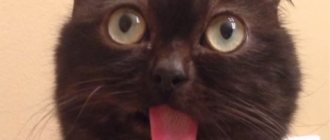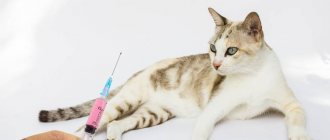Many cat owners are sure that their pets can also get the flu. Along with news about bird or swine flu, information about dog or cat flu periodically appears in the press. But in fact, there is no such disease as cat flu, says Natalya Solovyova, chief physician of the veterinary clinic. Rhinotracheitis causes symptoms similar to human influenza in cats. This is what is often called cat flu, the symptoms and treatment of which raise many questions among animal owners.
What is feline rhinotracheitis?
Feline rhinotracheitis (called “flu” in cats) is a disease caused by the herpes virus. It is manifested by inflammatory processes: fever, purulent discharge from the eyes and nose. Conjunctivitis may be accompanied by damage to the cornea - the transparent film of the eye may become cloudy.
Questions and Answers How to check if there is an allergy to a specific cat?
Purulent rhinitis, when the microflora worsens, leads to the appearance of thick green discharge from the cat’s nose. “A cat cannot switch to mouth breathing, unlike a dog. This is a rare occurrence for a cat, possible only in case of hypoxia, a lack of oxygen. The animal breathes with great difficulty, so rhinotracheitis is also accompanied by hypoxia. Also, the cat cannot eat food normally because the nose is completely clogged. Refusal to eat in this disease also occurs due to inflammatory processes in the body,” says Natalya Solovyova.
In general, as the veterinarian notes, rhinotracheitis is a fairly serious disease if left untreated. “It is especially dangerous for young cats and kittens. A fatal outcome as a result of rhinotracheitis is possible only if the disease occurs in combination with other complications. This is most often found in street animals; they, as a rule, are carriers of a large number of diseases,” the expert notes.
Weak kidneys and oncology. What can dogs and cats of different breeds die from? Read more
Treatment at home: what medications can be given?
There are no special medications to treat colds in cats. Veterinarians recommend treating the disease with drugs that boost immunity and relieve symptoms. During therapy, the pet needs to be provided with comfortable living conditions, proper nutrition and rest.
Antibiotics
Colds in cats are treated with antibiotics when bacterial infections occur. Drugs must be selected with caution. Not only the recovery, but also the life of the pet depends on this. The most commonly prescribed medications for cats are:
- oxytetracycline;
- gentamicin;
- amoxicillin;
- chloramphenicol;
- kanamycin.
It is important to correctly calculate the dose of the drug, which depends on the weight, age and general condition of the cat’s body. For colds in cats, treatment at home involves following the administration regimen drawn up by the doctor. Otherwise, the drug is ineffective. The course of antibacterial therapy lasts 7-10 days. You should not interrupt treatment, even if the symptoms disappear after 3-4 days. If you refuse further administration of antibiotics, the infection may become chronic.
Injections
Both antibiotics and immunostimulating agents are injected. The administration of vitamins has a positive effect on the cat's condition. If the cold is severe, the animal can be treated with interferon. The product has a high price and has a number of side effects. It can be replaced with immunoglobulins - antibodies obtained from a recovered animal. They act only in the first days of illness. It is recommended to give injections to your cat at a veterinary clinic.
Nasal rinsing
The procedure helps clear the nasal passages of mucus secretions and restore breathing. For this purpose the following drugs are used:
- 2% zinc sulfate solution;
- 3% boric acid;
- 0.5% tannin solution;
- a mixture of adrenaline and novocaine.
A small amount of liquid is drawn into a pipette or syringe without a needle. The animal is placed on its side, holding its head. The medicine is injected into the nasal passage and the animal is allowed to lie down. After washing, you can drip a mixture of 1% methanol and fish oil. This remedy softens the mucous membranes, eliminating signs of irritation and inflammation.
Use of human medicines
In treating a cat, you can use some of the remedies used to treat colds in humans. Derinat and Nazivin drops help to cope with a runny nose. The recommended single dose for an adult cat is 1 drop. The use of some medications from a human medicine cabinet can be fatal to a pet. Antipyretics based on paracetamol and aspirin are toxic to cats. In addition, due to the small weight of the animal, it can be difficult to calculate and obtain the required dose of the drug.
Can a cat infect a person with rhinotracheitis?
According to the veterinarian, rhinotracheitis is strictly a specific disease of cats. Therefore, they cannot infect humans or other pets, such as dogs or hamsters, with it.
A cat can only become infected through contact with a sick animal. “If the animal is domestic and has no contact with other cats, it has no risk of becoming infected. But it happens that owners pick up an unfortunate “crying” kitten on the street and bring it home, and as a result, the domestic cat begins to get sick with everything that the kitten brought from the street. In addition, there are animals that can be carriers of the virus, but it can manifest itself clinically in them,” explains Solovyova.
Also, the pet runs the risk of contracting herpes if the owners rent it out to a cat hotel for a while. “Bringing animals into a cat hotel without a passport is fraught with problems. If maintenance and hygiene standards are not observed there, theoretically, the animal can get sick. But, as a rule, such establishments accept animals with vaccination or they are injected with a prophylactic serum, which works for 15 days. This is passive immunity during the stay in the hotel,” says the veterinarian.
Cat and mouse. Can a pet eat caught birds and rodents? More details
Can it become infected from a person?
It is recommended to give pets medications that increase immunity.
According to veterinarians, the risk of infecting a pet with a disease of the bronchopulmonary system or rotavirus is minimal, since viral infections differ for humans and animals. The cold is not a contagious disease and is caused only by exposure to low temperatures. A common sore throat or flu is not dangerous for a cat, even if it is constantly surrounded by sick owners.
To prevent respiratory diseases in a cat, veterinarians recommend giving him immunomodulators for preventive purposes, for example, Aminosol, Anfluron or Gamavit.
However, mutated strains of infectious diseases can be transmitted between different species, for example, there was an officially documented case of swine flu infection, which led to death from pneumonia. The disease can be identified in the initial stages by loss of appetite, dry nose and general lethargy. According to veterinarians who conducted feline serology studies, pets are highly susceptible to influenza.
How is the disease treated and prevented?
According to Solovyova, proper vaccination protects against rhinotracheitis by 99%. “Vaccination is carried out for cats in childhood twice with an interval of 3-4 weeks, then it is done strictly once a year. If it is missed several times and there is a gap of 2-3 years, you have to do a second two-time vaccination,” explains the expert.
If your cat has not been vaccinated and becomes ill, you should contact your veterinarian. “Since this is a viral disease, treatment begins with the administration of antiviral globulins and serums. In parallel, antibiotics can be used as additional therapy, since viral diseases are always accompanied by activation of microflora. An antibiotic, as is known, does not act on viruses, but fights bacteria that aggravate the course of a viral disease. Additionally, sick cats should be given vitamins; sometimes they are added to immune preparations,” says Solovyeva.
The condition called flu in cats requires complex therapy. It cannot be ignored, as complications may arise.
Prevention
A cold is not dangerous for an animal with normal immunity, but the disease causes discomfort to the cat and is quite difficult to treat. It is much easier to prevent infection. The following measures help with this:
- Proper care of animals. For the first few weeks of life, kittens should be kept in a warm, draft-free room. Trays and sleeping places for adult animals should also not be in rooms with cold air.
- Gradual adaptation to the street. You need to start this procedure in the warm season. The cat is allowed outside for several hours. In this case, you need to ensure that the animal does not become hypothermic. In rainy and windy weather, walks are avoided.
- Proper bathing. The cat needs to be bathed with warm water. After the procedure, the fur is thoroughly dried with a towel, while the pet should be in a warm room.
- Proper nutrition. The diet should include balanced food and sufficient fluids. Do not give your cat cold food or water.
Cats with a compromised immune system are susceptible to colds, so you need to take care to increase the body's defenses. Vitamin supplements selected by a veterinarian help with this. Vaccination also helps protect your cat from diseases.
What causes cat flu
This disease has several causative agents (pathogens):
- Feline herpesvirus FHV-1 (Feline Herpes Virus type 1) is the causative agent of infectious rhinotracheitis.
- Feline calicivirus FCV is the causative agent of calicivirus in cats.
- Chlamydophila Felis is the causative agent of chlamydia.
- Bordetella Bronchiseptica is a bacterium that affects the respiratory tract of cats and dogs (kennel cough).
Clinical signs of the disease, its methods of diagnosis and treatment depend on the type of pathogen.
Lichen
Ringworm is caused by microscopic pathogenic fungi. They mainly affect the fur and skin of the animal. The most common fungal diseases in cats are trichophytosis and microsporia. Ringworm in cats is manifested by the formation of rounded areas of baldness on the skin. These areas are most often located on the pet’s head, limbs, and tail. The skin in these places turns red and peels. The hair around the bald area becomes brittle. The cat licks and combs the affected areas.
Cats become infected from sick animals through direct contact, as well as through care items. A person can become infected in the same way, for example, by petting a sick pet.
Diagnostics
Diagnosis is carried out in a veterinary clinic after a comprehensive assessment of the animal’s condition, taking into account the epidemiological situation in the cat’s place of residence. The doctor examines the animal, assesses its condition, and analyzes the clinical picture of the course of the disease.
Additionally, laboratory tests are carried out:
- urine and blood analysis;
- PCR – growing virus strains from swabs taken from a cat’s mouth and eyes;
- Ultrasound;
- radiography.
Additional diagnostics are necessary in severe and advanced cases, when signs of a secondary disease are clearly expressed.
Symptoms of the disease
Cats have a unique physiology, so when they have a cold, they may have a hot, dry nose, poor appetite, drowsiness, fearfulness and apathy. However, the symptoms listed are also typical for other cat ailments. Among them is infectious pneumonia in cats, the symptoms and treatment of which differ in some ways from the symptoms and treatment of the common cold. To accurately diagnose a cold, it is worth paying attention to other warning signs that are a signal for owners and indicate the need to visit a veterinary clinic.
Typical clinical symptoms of a cold in cats are presented as follows:
- greenish discharge from the sinuses;
- weakness, fatigue;
- difficulty breathing through the nose;
- irritation of mucous membranes;
- sneezing and coughing;
- tearfulness of the eyes.
If the owner suspects that the pet has a cold and has the symptoms listed above - lethargy, watery eyes, coughing in cats, the symptoms and treatment of the disease must be confirmed by a veterinarian.
Treatment
Remember that a cat’s cold is not the worst disease, but you shouldn’t hope that it will go away on its own.
If you notice signs of a cold, do not ignore them: it is better to take your cat to the veterinarian than to wait for the situation to get worse. The correct treatment regimen is prescribed only after the pet has been examined by a doctor and a diagnosis has been established. It is prohibited to take measures on your own - this can harm the animal and worsen the situation.
The owner’s task is to provide the cat with the most comfortable conditions for recovery. Measures taken to achieve this should include:
- eliminating drafts;
- control over keeping the pet warm;
- providing the cat with warm drinks, including milk;
- You can give your cat a massage - this will improve blood flow and warm the animal.
The doctor may prescribe rinsing the nose with special drops. If inflammation is detected, it is necessary to give the cat anti-inflammatory drugs, and if the temperature is high, antipyretics.
In some cases, the doctor will prescribe antibiotics to kill infections. In this case, additional medications may be prescribed to restore the intestinal microflora.
For a cat, a cold is an unusual occurrence, and visiting a veterinarian and taking pills is stressful for an animal. Therefore, give your pet enough time and attention so that he does not feel lonely.
You can reward your cat with a treat after she eats a pill or visits the vet.
The lack of therapeutic measures can lead to complications and the development of other diseases, which include bronchitis, pneumonia, and kidney disease.










